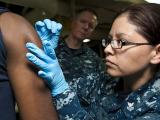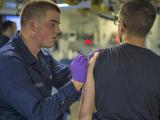Mar 29, 2002 (CIDRAP News) – A federally sponsored study indicates that smallpox vaccine in the US stockpile remains potent after being diluted five-fold and ten-fold, suggesting that the 15-million dose supply now available can be stretched much further, according to a report published online yesterday by the New England Journal of Medicine.
The report was one of two nearly simultaneous developments that promised a huge increase in the nation's reserve of smallpox vaccine to guard against bioterrorist attacks. The other was today's announcement by Aventis Pasteur that it will donate its own stockpile of 75 million to 90 million doses—previously undisclosed to the public—to the federal government (see related story).
The Department of Health and Human Services (HHS) currently has 209 million doses of smallpox vaccine on order from Aambis Inc. and due for delivery by the end of this year. HHS officials said today that by diluting the existing stockpile of 15.4 million doses five-fold, yielding 77 million doses, they expect to have a total of 286 million doses by the end of the year. If tests show that the Aventis vaccine is still effective, it will expand the stockpile even further, officials said.
Commenting on the dilution study, HHS Secretary Tommy Thompson said in a news release, "The public health implications of this study are enormously important. We now know that in the unlikely event of an intentional release of smallpox, our stockpile of smallpox vaccine can be expanded fivefold as we had planned. The success of this study puts us one step closer to our goal of having enough vaccine for every American if needed to respond to a potential outbreak."
The dilution study was released early in electronic form because of its public health interest. The trial, sponsored by the National Institute of Allergy and Infectious Diseases (NIAID), compared the full-strength vaccine with five-fold and ten-fold dilutions in 680 young adults (age range, 18 to 32) with no history of smallpox vaccination. Conducted at four sites, the study was led by Robert B. Belshe, MD, and Sharon E. Frey, MD, of Saint Louis University.
Participants were randomly assigned to one of three groups, with 106 receiving full-strength vaccine, 234 receiving a 1:5 dilution, and 340 receiving a 1:10 dilution. Investigators administered the vaccine by pricking the skin 15 times with a two-pronged needle and then monitored the volunteers for 56 days. After one vaccination, 97.8% (665) of the participants responded with a "take" in the form of a blister-like sore at the injection site. Those who did not have a sore after 7 to 9 days were revaccinated.
After one or two vaccinations, there were no significant differences in the take rates of the three groups: 97.2% for the full-strength group, 100% for the 1:5 dilution group, and 98.8% for the 1:10 dilution group. Only eight participants did not have a response after two vaccinations, and five of these had preexisting antibodies to vaccinia, suggesting that they had been vaccinated in infancy, the report states.
Other than the injection-site blister, adverse side effects were mostly mild to moderate and were common among all three groups. Common side effects included headache, muscle aches, chills, nausea, fatigue, lymphadenopathy, injection-site pain, and satellite lesions. The undiluted vaccine caused greater injection-site inflammation and regional lymphadenopathy, while diluted vaccine more often caused satellite lesions.
"Many clinicians may not realize that smallpox vaccination causes an acute illness in adults who've never received the vaccine before," stated Belshe in the HHS news release. "None of our volunteers experienced life-threatening reactions, but about a third had symptoms that were significant enough to make them change their normal daily activities."
Results of a small pilot study that was used to design the main dilution study also were published online by NEJM today. In that study, 60 previously unvaccinated young adults received either full-strength vaccine, a 1:10 dilution, or a 1:100 dilution. Those receiving the 1:100 dilution had a low response rate, but 95% responded to the full-strength vaccine, and 70% responded to the 1:10 dilution. The lower response rate to the ten-fold dilution in the pilot study than in the main study may have been due to the different vaccine lots used, according to the HHS release. The vaccine lot used in the larger study had a higher initial concentration of virus.
In an editorial accompanying the dilution studies, NIAID Director Anthony S. Fauci, MD, calls for a public dialogue on the advisability of universal smallpox vaccination. Current federal plans regarding smallpox immunization call for "ring vaccination" (a vaccination campaign focusing on contacts of infected people) in response to actual outbreaks rather than advance universal vaccination. A major bioterrorist attack could overwhelm health agencies' ability to carry out an effective ring vaccination campaign, but mass vaccination would probably cause one or two deaths and hundreds of cases of generalized vaccinia and other serious side effects per million recipients, Fauci says.
"Since sufficient stores of smallpox vaccine will soon become available, an open and public dialogue on the advantages and disadvantages of universal voluntary vaccination, as well as on the smallpox response plan of the CDC, should be initiated before any attack occurs," Fauci states. Such a dialogue would strengthen public confidence in the government's response plans, he adds.
Frey SE, Couch RB, Tacket CO, et al. Clinical responses to undiluted and diluted smallpox vaccine. N Engl J Med 2002 Apr 25;346(17):1265-74 [Full text]
See also:
HHS press release describing the dilution studies
http://archive.hhs.gov/news/press/2002pres/20020328b.html


















